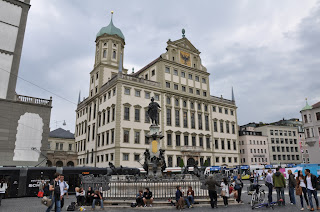On our way to Munich on Saturday morning, we stopped in Dachau to see the WWII era concentration camp. It was definitely an eerie feeling to walk around a place where such cruel and inhuman acts took place.
Here's a photo of the infamous gate with the (loosely translated) phrase "Work Liberates".
Before visiting Dachau, I wasn't really aware of the distinction between a "concentration camp" and an "extermination camp" (Dachau being an example of the former; Aushwitz-Birkenau, the latter). As demonstrated by the absolutely devastating pictures on display in the museum, however, the distinction between the two camp types seems to have been fuzzy.
I don't know if there's any way to really describe the camp other than pure evil. I can't imagine how people found the will to "live" while facing such conditions.
***
We arrived in Munich to a much more festive atmosphere: Saturday night was the UEFA Champion's League Final (basically the Super Bowl of European soccer) between Bayern Munich and Chelsea (London). And similar to the Super Bowl, the host venue rotates irrespective of the two teams that have reached the final. Thus, it was purely coincidence that Bayern was able to play the final in its hometown. This definitely added to the craziness.
We began our Munich visit by walking to the Neues Rathaus (New Town Hall), which was built in the late-19th century and faces one of the city's major plazas -- the Marienplatz.
For a better view of the city (and to escape the rabid football fans for a few minutes), we decided to head up to the top of the building's main tower. And at nearly 300 feet, the tower indeed offered a fantastic view. Here's a photo of the nearby St. Peter's Church (Peterskirche), which is the oldest church in the city center and dates back to the 14th century.
We then walked around the city a bit to get a better feel for it. As with the other Bavarian towns that we visited, the architecture was very interesting. And perhaps most impressive, a good deal of it had to be completely restored after being destroyed by Allied bombing during WWII. To the left of the picture below is (part of) the famous Hofbräuhaus.
As we continued our self-guided tour of the city, we saw a number of churches (most notably the Frauenkirche and the Theatinerkirche). We also passed the National Theater (pictured below), where we had tickets to see I Capuleti e i Montecchi (an opera version of Romeo and Juliet) later in the evening.
We finished off our sightseeing on Saturday by visiting two of Munich's famous art museums -- the Alte ("Old") Pinakothek and the Neue ("New") Pinakothek. The first houses a vast collection of works by the "Old Masters" (pre-19th century European painters, I subsequently learned), while the second contained works by 19th century painters.
The general area around the museums is known as the Kunstareal ("Art District") as there are a number of other museums to visit there as well. The area is also home to the Königsplatz, a square that was often used for Nazi rallies during the Third Reich.
After finishing up with the museums, it was time to head back to the hotel to change for the opera. And In order to save some time, we decided to take the metro. This led to one of our more interesting Munich experiences, as a four-person rock group (singer, guitarist, bassist and drummer) got on at the first stop and started performing on the train (the drummer and guitarist are visible in the picture below).
I have to say that it was pretty cool and the other passengers -- most of whom were on their way to pre-party for the evening's football championship -- were loving it.
Our subsequent metro ride to the opera turned out to be equally interesting, as we ended up being on the same line that went to the football stadium. As such, the train was packed like sardines with sweaty, drunk fanatics singing their teams' songs at the top of their lungs. There were literally crowd control police at each metro stop in order to prevent stampedes. Fortunately, we were able to force our way off the train at our desired stop, though we probably smelled like we were coming straight from Oktoberfest.
Despite having to follow up our two interesting metro experiences, the opera managed to do a good job of keeping us entertained. I think it helped that I was familiar with the story of Romeo & Juliet. Otherwise, I would have been lost given the Italian lyrics and German subtitles.
After the opera we grabbed a very nice dinner and then headed to a bar to watch the end of the football champtionship. We arrived in time to see the overtime period and the shoot-out, during which the fans were going crazy. Here's a photo after Munich took the lead in the shoot-out.
Unfortunately, it wasn't meant to be for the local team. Shortly after the above photo, the momentum shifted and Chelsea won the shoot-out. I don't know if I've ever seen the collective life get sucked out of a city so quickly. But at least they handled the loss gracefully. I have a feeling things could have gotten a little ugly had Chelsea been the team that lost given the craziness that we had witnessed earlier on the metro. The word hooligan comes to mind.


















































